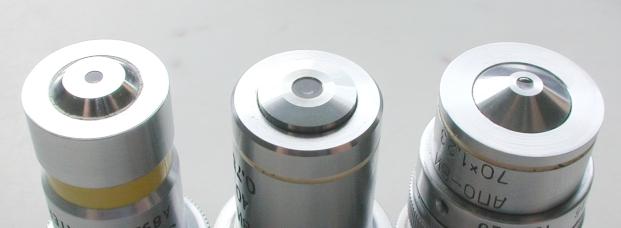 |
| Water Objectives A personal exploration............all is not what it seems. By Paul James (UK) |
My initial, imagined understanding of the phrase 'water objective' was that it was designed to allow the observer the freedom to dip the objective into the water sample without the need of a coverslip. (Memories of images spring to mind of submersible 'bathescapes' and the like freely roaming through deep sea water allowing the occupants the luxury of peering into the unknown in relative comfort !) Back to reality.......Such a state of observation is at once in theory a highly desirable technique, and indeed in practice with some cautionary proviso's it is. The idea that you can just dip the objective's eye into any part of the water and search ad infinitum without worrying about coverslips, physical depth limitations and correction collar requirements etc seems a real joy. But there is much more to all this than first imagined........
DESIGNATION
First and foremost.........Not all water objectives are designed to operate directly in the sample water as some are corrected to be used just like an oil immersion lens having water immersion contact with a coverslip over the specimen. Their designations are usually known as 'Water Dipping' and 'Water Immersion' respectively. However, it seems from the engravings on about 5 or 6 'water' objectives I've seen that this less than subtle difference cannot be readily ascertained.
Would be purchasers should therefore be aware of this distinction and other matters that I raise later. I say this because the corrections for spherical aberration are different in each type, and the fact that water comes into contact with both their front elements does not mean that they have identical characteristics. When each is used by mistake : ie when the water dipping form is focussed over a coverslipped preparation with water as immersion fluid, its image might be less than perfect and visa versa. The degree of imperfection varies and can be significant. Yet I have also found that there are examples of 'water' objectives that behave fairly well in both camps especially if using brightfield? So the distinction is not such a very crisp and clear one.
Add to these, are examples of high power immersion objectives that have correction collars which are designed to be able to adjust for coverslip / dipping variations and those that can use oil, water, glycerine etc..
So water objectives are basically divided into 3 groups
1) Water immersion ( using water as immersion fluid over coverslipped preparations )
2) Water immersion with correction collars.
3) Water dipping ( direct observation of specimens in sample water )
Using Water objectives
 |
The Water Immersion objective is a delight to use, principally because the immersion fluid is so easy to apply and more importantly, remove. Air bubbles can be a nuisance as with oil immersion fluids, but this is an unavoidable part of immersion fluid observation technique, and regular use of a phase telescope or peeping down the draw tube at the objective's back lens will reveal the presence of any bubbles. Ignoring this simple procedure will inevitably result in significant image deterioration at times, since some bubbles can be so large as to cover half the lens. The quality of imaging however can be excellent, and I thoroughly recommend the water immersion objective, even though their maximum aperture is usually less than their oil dependent cousins. For most occasions the condenser can be left dry unless DF is required and water can be used for immersion contact with the under surface of the slide. The ease and speed with which water can be mopped up after using this objective is a delight to behold and one wonders why there are so few available ??
The Water Dipping forms are a different breed altogether and take time to get accustomed to; more especially the high power versions. I think one reason is that we may have a preconceived notion as to what can be done with the objective. Imagining that ciliates will conveniently wander in front of the objective at precisely the correct working distance, and stay there and pose for us is not born out in reality. The low power forms are easier to use, and of course with the field being large observing aquatic forms in their free moving state is comparatively easy. With the highest power forms the practical way to observe is to lower the objective slowly and carefully till the glass slide's surface, and any debris and 'bottom' dwellers are apparent. Here the water dipping objective comes into its own and those critters that lurk naturally on the slide's surface can be scrutinised as easily as when using an ordinary objective over a coverslipped slide.
The problem in high power water dipping observations is that of not easily seeing creatures in mid stream as it were, moving vertically as well as horizontally. These particular subjects are best viewed under a coverslip which at least limits their acrobatics to within the working distance range of the objective. The irony here is that this tends to increase their horizontal activity !
A potentially significant problem, depending on your sensitivity, is that the 'pool' of water on the slide is very likely to vibrate when using the dipping forms, being caused by even the most delicate manipulation of the microscope. The breath can cause jelly like tremulations which directly oscillate the specimens, especially those in suspension. Organisms that cling to the glass usually hold fast and are not affected, which include many of the protozoans such as amoebae. So critical observations and photography of the more freely suspended specimens tend to be snatched in 'no hands and bated breath moments' ! Here the IR remote control on digital cameras is highly desirable. A ring as described below reduces the wobbling and is therefore recommended.
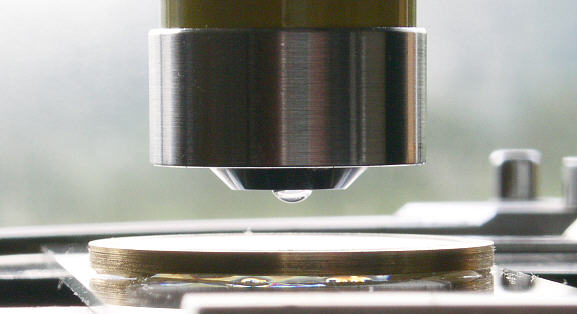 |
Brass/aluminium or plastic rings or rectangular forms like the one shown above help in a number of ways. Firstly they avoid water slopping about and don't have to be bonded to the slide as they do the job just resting as is, and being loose avoids collisions with objective shoulder or bezel during scanning..... 2-3mm thickness is adequate for normal use.
The other great advantage is that the water surface is flat when loaded to the top edge and so the views through low power objectives are exceedingly good without water caps when pre scanning etc..
A deep ring is not recommended since the objective's shoulder could be accidentally lowered onto it. The working distance of this example below clears the shoulders easily allowing a fair degree of elbow room across the slide's surface. Of course a 3" x 2" slide and larger ring would be easier to use, but it is not essential.
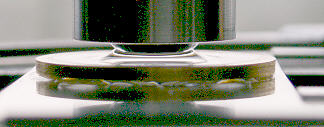 |
Illumination with water objectives
As far as I have found both types of water objective behave well under Brightfield/Oblique illumination. COL works extremely well with water immersion objectives, and can do so with water dipping provided the water sample is free of fine particles. Darkfield's success relies on clean water as colloidal suspensions cause diminishment of contrast through light scatter.
Some cautionary measures for general use
There are 4 instances in their use when a little care should exercised.
1) Air bubbles intruding in the light path in front of the glass element are a constant nuisance when first dunking the objective. To avoid this it is best to raise the objective in the first instance and wet the front element with a small paint brush flooded with water which can also place a drop over the coverslip too. A plastic spoon can be used to offer the water to the front face also if preferred, as shown further below.
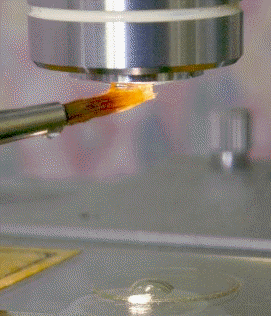 |
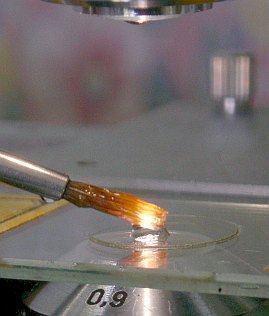 |
2) When finishing with the water dipping objective it is best to dip it into clean water which can safely and conveniently raised to it in a plastic spoon. The purpose of doing this is to prevent any gritty debris from remaining on the glass face. It is rather surprising at times that the surface tension of water whips up some debris off the slide when it is raised for drying, and can leave the drop of water that clings to the front element with a few suspended particles . The spoon technique helps to eleviate this problem, and so that a tissue can then be applied gently which will 'dry' the face of the objective almost immediately. Note how easily an air bubble gets trapped as shown below :-
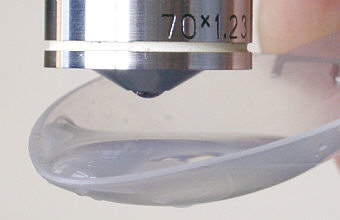 |
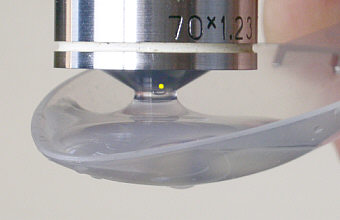 |
3) Some high power water objectives don't sport spring cushioned noses and the chances of collision damage with the slide/coverslip is high, so great care must be exercised when lowering the objective. Subconsciously revolving the objective changer to bring the high power water dipping objective into use after low power scanning must be avoided. Cultivating the habit of raising then lowering the objective slowly into the water sample avoids front element damage from gritty particles........unlikely but possible because of small working distances. Pre-scanning at low power is essential, followed by focussing of the high power optic very carefully. It can also be frustrating after low power location that the high power water dipping objective often disturbs the position of the specimen by its very presence!
4) It soon becomes obvious that the ideal samples for the higher power water dipping objectives are relatively clear of unwanted debris and mud. Here the objective comes into its own when its nose cannot 'drag' clumps of algae and debris along as the slide is scanned. I find a pool of water containing debris only just visible to the eye is about right, leaving plenty of space for the individual forms of life to roam and the objective's eye to wander without impediment too.
Here are I believe two practical advantages of each type :-
1) IMMERSION.....Importantly, if you have a collection of very delicate and precious slides such as Victorian slides of diatoms/butterfly scales etc. and you are concerned about the cumulative effects, both mechanical and chemical, of immersion oil removal which might loosen the coverslip, then get an equivalent water immersion objective if you can because the removal of water, as you might imagine with a dab of a tissue can be performed with virtually no mechanical contact of the slide !
2) DIPPING..... The frustration of not being able to focus the dry x40 objective over a coverslipped sample of 'pond water' because the water film is unavoidably thick is not a problem with the dipping forms............provided great care is exercised as mentioned above.
A prudent exercise ?
If you obtain a dipping objective of highish power including x40 and above, then I suggest a very worthwhile exercise which will give confidence in use by revealing safely the working distance etc..
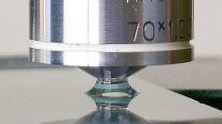 |
Before using it on live material I suggest setting up a clean slide with a fat water drop and slowly lowering the objective. Using brightfield and with the iris well stopped down to enhance the diffraction effects around particles that exist on the slide, allows for easier recognition of the slides top surface. When focussed, you will feel far more confident about using it over a pool of sample water on the slide. So absorbing all the water with a piece of tissue whilst at it's focussed position will clearly reveal the scale of the working distance which is always smaller than imagined !! It would not be too cautionary a procedure to use your coarse focus stop to prevent further lowering of the limb: the fine focus doing the final tweaking thereafter.
Pro's and Con's
Water objectives are few in number on the used markets and so when one does come up for sale its suitability for your needs will no doubt be uppermost in your mind. In reality those interested will buy a water objective and see how they get on with it........many people have done this. Lomo make a number: x30 x40 x70 x 80 as do Olympus and Nikon, Zeiss and Leitz, but the former are significantly cheaper and are perfectly adequate for the job.
Highest powers such as the x 70 ( na 1.23 ) Russian water objective call for more careful handling and more specific usage, and comes into its own working over small algae, bacteria and tiny protozoans.
Low powers are I think of less usefulness to the amateur pond dipper, as the ordinary dry objective can reveal much by hovering over uncoverslipped water retained within a brass ring. The x5 and x10 can, because of their relative insensitivity to coverslip variation and large working distance, scan the shallow water pools on slides with consummate ease to locate specimens subsequent to examination by the water dipping optic.
Ideally a x20 or x30 will encompass most interesting aquatic specimens for general use and the Lomo x30 version with high na 0.9 can be also used with higher power oculars as a bonus.
It is in essence a catch 22 situation because no one can really expect to make a decision without first having the experience of using one...........especially the 'dipping forms'. The 'Immersion' form is used in exactly the same way as with oil forms, so decisions about purchasing are a lot simpler for those who have used the oil varieties. The Lomo x40 0.75 na achromat water objective can be obtained for about £20 new. It is a good optic and can be used for BOTH purposes, but appears to me to be more suitable for dipping.
Conclusions
The water immersion objective is without doubt an optic which is very easy to become fond of. A drop of water is all that is required to elicit the higher than average na that the x 40 dry optic's tend to have. The slight inconvenience of the use of water is a trifle compared to the potentially messy and time consuming procedure of oil objective usage. It's image quality can be stunning.
The water dipping form of this tempting series of optics needs time to get accustomed to. By comparison to the immersion optic they are hard work, especially the higher powers x40 upwards requiring careful focussing procedures and reduced selection of suitable specimens. They do have the advantage of optical simplicity between the specimen and front lens, and it often shows with clarity. The principal advantage of use of water dipping objectives is that the living life forms are not starved of oxygen by the coverslip, and so their behaviour is more likely to be normal over an extended period of time. Water evaporation, a well known phenomenon when observing coverslipped aquatic preparations, can be avoided by easy addition of more water which causes less disturbance than when added to the side of the coverslipped preparation. Those interested in long term observations who find that the duration of the specimen's life essential to their branch of research will find the water dipping optics a blessing, despite their innate foibles.
The high power water dipping forms rely on careful and intelligent use with sensible selections of specimen types to reveal satisfying imagery to justify their relatively high cost. If you are quite satisfied with your present method of viewing live aquatic specimens under a coverslip then the water dipping objective offers little improvement. If you are a keen rotifer observer, the freedom they will 'enjoy' might displease you as a vertically aligned specimen feeding is not ideally suited to observation?!
If however your first water objective provides acceptable imagery in both camps, then clearly it is a bonus. My relatively modest experience of all this indicates that this is a distinct possibility, and whilst the high power water dipping objective tends to have limited scope, this initially inhibiting impediment will, with the help of some perseverance and thoughtful application, open up new fields of exploration.......hopefully !
In a nutshell however the water immersion objective is an odds on winner.
Chinese proverb: Water dipping objectives might whet appetite but may bring dampened spirits?!
| All comments welcome by the author Paul James |
Microscopy
UK Front Page
Micscape
Magazine
Article
Library
Please report any Web problems or offer general comments to the Micscape Editor.
Micscape is the on-line monthly magazine of the Microscopy
UK web
site at Microscopy-UK